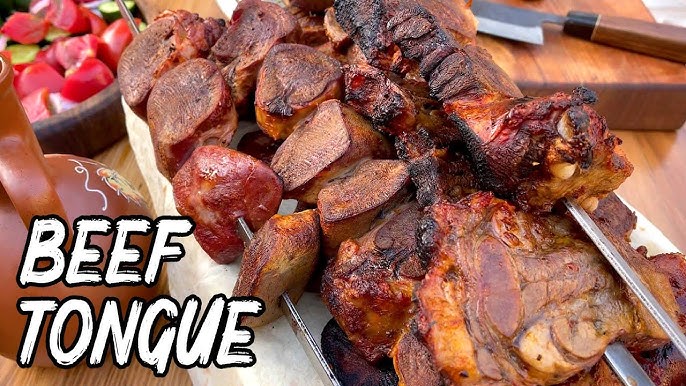Beef Tongue Recipe: Let’s be real: beef tongue might not be the first thing that comes to mind when you’re planning dinner. But don’t knock it until you try it! Beef tongue is a surprisingly tender, flavorful cut of meat that’s popular in many cultures—Mexican tacos de lengua, Jewish deli tongue sandwiches, and Eastern European stews, just to name a few.
Now, before you squirm at the idea, here’s the truth—beef tongue, when cooked properly, tastes a lot like a melt-in-your-mouth roast beef. It’s juicy, rich, and super satisfying. Plus, it’s affordable and often overlooked, which means you can get a lot of bang for your buck.
What makes it even better? It’s full of nutrients like iron, zinc, and B vitamins. And despite what you may think, it’s not tough or gamey at all. In fact, the tongue is one of the most tender cuts once it’s cooked low and slow. This guide will walk you through everything—from choosing the right tongue to cooking it perfectly and peeling it like a pro.
Selecting the Right Beef Tongue
You can’t make a killer dish without starting with quality ingredients. So let’s talk about how to pick the best beef tongue for your meal.
Where to Buy Quality Beef Tongue
You’ll usually find beef tongue in butcher shops, specialty meat markets, or the meat section of international or Hispanic grocery stores. Some mainstream supermarkets carry it too, often frozen. If you’re lucky, you might even score a fresh one.
When buying, go for one that’s pale pinkish-gray, not dark or discolored. It should have a firm texture and minimal odor. Avoid any that feel slimy or have an overpowering smell—those are clear signs it’s past its prime.
Tips for Choosing the Best Cut
Beef tongue typically comes whole and unpeeled. This means it’ll still have the thick outer skin, and it may even have the base attached (the part that connects it to the cow’s throat). That’s okay—it all comes off after cooking.
Here’s what to look for:
- Size: A medium to large tongue (2.5 to 4 pounds) is ideal. It shrinks during cooking, so don’t be fooled by its initial size.
- Fat: Some fat is good—it adds flavor—but too much excess fat around the base can be trimmed.
- Color: Consistent coloring is key. Avoid any with dark blotches or uneven shades.
Once you’ve got your beef tongue, you’re already halfway to an amazing meal.
Preparing the Beef Tongue for Cooking
Now that you’ve got your tongue, it’s prep time. This is the part where most people hesitate, but don’t worry—we’ll keep it simple and clean.
Cleaning and Trimming the Tongue
Start by rinsing the tongue thoroughly under cold running water. Use your hands to gently scrub off any blood or debris. Some people soak it in cold water with a splash of vinegar for 15-20 minutes to remove any lingering odors.
Once rinsed, trim off any visible fat or glands from the base. You don’t have to go overboard—most of the undesirable parts will come off easily after cooking. But a little trim now helps cut down the cooking time.
Essential Tools You’ll Need
Cooking beef tongue doesn’t require fancy equipment, but having the right tools makes things smoother:
- A large stockpot or Dutch oven
- A sharp knife for trimming and slicing
- Tongs or a fork to handle the hot meat
- A cutting board
- Optional: a pressure cooker or slow cooker if you want an alternative method
That’s it—your beef tongue is now ready for cooking!
Cooking Methods for Beef Tongue
There are several ways to cook beef tongue, but the most popular and foolproof method is boiling. Here’s a breakdown of your options.
Boiling Method Explained
Boiling is the classic way to prepare beef tongue. It keeps the meat moist and tender while allowing the outer skin to loosen up, making it easy to peel off later. Simmer it low and slow for about 2.5 to 3.5 hours, depending on the size.
Add aromatics like onion, garlic, bay leaves, peppercorns, and salt to infuse flavor while it cooks. The result? A juicy, rich cut of meat that’s full of depth.
Slow Cooker Option
Don’t want to babysit the stove? Throw the cleaned tongue into a slow cooker with your favorite herbs and spices, cover with water or broth, and cook on low for 8–10 hours. It’ll come out fall-apart tender, and the aroma? Absolutely irresistible.
Pressure Cooking for Faster Results
Short on time? Use a pressure cooker! It can cut the cooking time down to just 60–75 minutes. Add your aromatics and water or broth, seal it up, and let the magic happen. The tongue will still be juicy and easy to peel, with all the flavor locked in.
Step-by-Step Recipe for Traditional Boiled Beef Tongue
Let’s get into the heart of this guide—a full step-by-step recipe you can follow even if you’ve never cooked beef tongue before.
Ingredients Needed
- 1 beef tongue (3–4 lbs)
- 1 onion, quartered
- 3–4 garlic cloves
- 2 bay leaves
- 1 tablespoon black peppercorns
- Salt (to taste)
- Water (enough to cover the tongue)
Step 1: Initial Cleaning and Rinse
Rinse the beef tongue thoroughly under cold water. Use your hands to rub off any surface debris. Trim off excess fat or gristle from the base.
Step 2: Simmering with Aromatics
Place the tongue in a large pot and cover it with water. Add onion, garlic, bay leaves, peppercorns, and a generous amount of salt. Bring to a boil, then reduce to a gentle simmer. Cover and cook for 2.5–3.5 hours, or until the tongue is fork-tender.
You’ll know it’s done when a knife slides in easily and the outer skin starts to peel off on its own.
Step 3: Peeling the Skin
Remove the tongue from the pot and let it cool just enough to handle. Using your fingers or a knife, peel off the thick outer layer of skin—it should come off in large pieces easily. If not, the tongue may need to cook a little longer.
Step 4: Slicing and Serving
Slice the peeled tongue thinly, across the grain. Serve it warm with mustard, horseradish, or in tacos, sandwiches, or stews. You can also sear the slices for a bit of extra flavor and texture.
Flavoring and Serving Suggestions
Once your beef tongue is sliced and ready, it’s time to decide how you want to serve it. This cut is extremely versatile and can be used in countless dishes, ranging from simple to gourmet.
Classic Presentation
A traditional way to serve beef tongue is simply sliced, sprinkled with salt, and paired with strong condiments. Think horseradish cream, Dijon mustard, or a zesty chimichurri sauce. These sharp flavors contrast beautifully with the tongue’s rich, soft texture.
Pair it with mashed potatoes or steamed vegetables for a comforting meal, or with rye bread and pickles for an old-school deli-style platter.
Mexican-Style Tacos de Lengua
This might be the most famous use of beef tongue in modern cooking. After boiling and slicing the tongue, sear the pieces in a hot skillet with a touch of oil until lightly crispy. Serve them in warm corn tortillas topped with diced onions, fresh cilantro, and a squeeze of lime juice.
Pro tip: Add a spoonful of salsa verde or a smoky chipotle sauce for extra depth.
Beef Tongue Sandwiches
Layer thin slices of tongue on fresh crusty bread or a toasted bun. Add mustard, pickled red onions, and a slice of Swiss cheese. You can even grill the sandwich like a panini for a crunchy, melty masterpiece.
In Stews or Stir-Fries
Since tongue absorbs flavor like a sponge, it works great in rich stews and Asian-style stir-fries. Cut it into cubes and let it simmer in your favorite sauce or gravy until all the flavors meld together.
Storing and Reheating Leftovers
Beef tongue stores exceptionally well, and the flavor often gets better after a day or two. Here’s how to handle leftovers so none of that goodness goes to waste.
Refrigeration Tips
After cooking, let the tongue cool completely. Store it in an airtight container with some of the cooking broth to keep it moist. It’ll stay fresh in the fridge for up to 5 days.
Make sure to separate the tongue slices with parchment paper if you’re storing them stacked. That way, they won’t stick together and are easier to reheat.
Freezing for Later Use
Beef tongue freezes beautifully. Wrap slices tightly in plastic wrap, then place them in a freezer-safe zip-top bag. You can also freeze the cooking broth in a separate container to use later.
It’ll keep well for up to 3 months. Just thaw overnight in the refrigerator and reheat in a skillet or microwave when ready to eat.
Reheating Techniques
To maintain that melt-in-your-mouth texture, reheat tongue slices gently. You can:
- Warm them in a skillet with a splash of broth
- Microwave them with a damp paper towel to retain moisture
- Heat in the oven covered with foil at 300°F for about 10–15 minutes
Avoid overheating—it’ll dry out the meat and ruin the texture.
Common Mistakes to Avoid When Cooking Beef Tongue
Cooking beef tongue isn’t hard, but there are a few rookie mistakes that can mess up your results. Here’s what to watch out for:
1. Not Cleaning the Tongue Thoroughly
Skipping the initial rinse or trimming can leave behind unpleasant odors or textures. Always take the time to rinse and trim before cooking.
2. Underseasoning the Broth
The tongue takes on the flavor of whatever it’s cooked in, so be generous with the salt and aromatics in your boiling liquid. Think of it like a blank canvas—infuse it with flavor from the start.
3. Not Cooking Long Enough
If the skin doesn’t peel off easily, the tongue isn’t done. Undercooked tongue is rubbery and tough. Be patient—it needs a good 2.5–3.5 hours (or more if large) to reach that perfect tenderness.
4. Peeling the Skin Too Soon
Wait until the tongue has cooled slightly but is still warm. If it’s too hot, it’s hard to handle. Too cold, and the skin becomes stubborn. Find that sweet spot and the skin will slip off like magic.
Why You Should Add Beef Tongue to Your Culinary Rotation
Still on the fence about beef tongue? Here’s why it deserves a regular spot in your recipe rotation.
Affordable and Nutritious
Tongue is often cheaper than more popular cuts like ribeye or sirloin, but it packs a serious nutritional punch. It’s high in protein, iron, vitamin B12, and zinc—all essential for energy, immune health, and overall wellness.
Versatile and Delicious
From tacos to sandwiches, to gourmet entrees, tongue adapts to almost any cuisine. It absorbs marinades and seasonings beautifully and works well in countless dishes.
Impress Your Guests
Let’s be honest—serving beef tongue is a conversation starter. When cooked right, it’s not only delicious but also shows off your culinary skills. Most people won’t even realize they’re eating tongue until you tell them!
FAQs About Beef Tongue Recipe
Is beef tongue healthy to eat?
Yes, beef tongue is surprisingly nutritious! It’s rich in protein, vitamin B12, iron, and zinc. However, it’s also high in fat, so enjoy it in moderation if you’re watching your intake.
How long does it take to cook beef tongue?
On average, beef tongue takes 2 to 3 hours to cook until tender when boiled or simmered. In a pressure cooker, it’s much faster—usually about 45 minutes to 1 hour.
Do you have to peel beef tongue before eating it?
Absolutely. After cooking, the thick outer skin becomes easy to peel off. Skipping this step would be like eating leather—don’t do it.
What does beef tongue taste like?
It tastes like super tender, melt-in-your-mouth beef. The flavor is mild and rich, and the texture is soft—kind of like a slow-cooked roast beef, but smoother.
Can you freeze cooked beef tongue?
Yes! Slice it first for easy reheating, then store it in an airtight container or freezer bag. It’ll stay good in the freezer for up to 3 months.
What’s the best way to serve beef tongue?
Popular options include tacos de lengua, sandwiches, stir-fries, or thinly sliced with mustard. Once it’s cooked and peeled, the sky’s the limit.
Can I use beef tongue in soup or stew?
Definitely. It’s perfect in hearty dishes—just dice it up and add it near the end to avoid overcooking that tender meat.
Conclusion
Beef tongue may sound intimidating at first, but it’s actually one of the most rewarding cuts of meat you can cook. With a bit of patience and the right techniques, you’ll get a meal that’s rich, tender, and bursting with flavor.
Whether you boil it for a traditional dish, toss it into tacos, or turn it into a gourmet sandwich, beef tongue has the power to surprise and delight. Plus, it’s budget-friendly, highly nutritious, and makes great leftovers.
So go ahead—step out of your comfort zone and give beef tongue a try. You might just find a new favorite.



